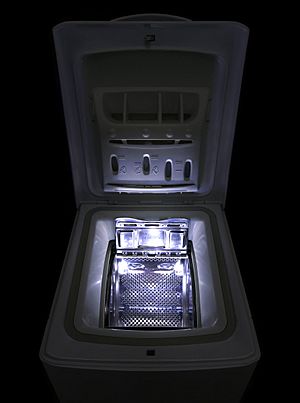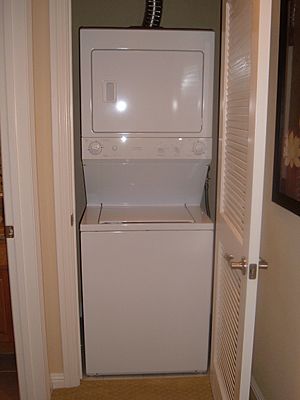Washing machine facts for kids
A washing machine is a helpful machine that cleans dirty clothes. It has a large drum inside where you put your clothes. This drum fills with water and then spins very fast. This spinning motion, along with detergent (which can be a liquid or a powder), helps to remove dirt from your clothes, making them clean again.
Contents
How Washing Machines Work
Washing machines have different settings to control how they clean your clothes. You can usually choose:
- The temperature of the water (hot, warm, or cold).
- How long the wash cycle lasts. This is the time the clothes spend soaking and spinning in soapy water.
- How many times the machine washes and rinses the clothes before it finishes.
Types of Washing Machines
Washing machines come in different types. Some are fully automatic, meaning they do everything by themselves. Others are partly automatic, which means you need to do a few things manually.
Semi-Automatic Washing Machines
Semi-automatic washing machines usually have two separate parts: one for washing and one for drying. You need to put your clothes into the washing part, add water and detergent yourself. Once the washing is done, you then have to move the wet clothes to the drying part. These machines are often less expensive.
Fully-Automatic Washing Machines
Fully-automatic washing machines are much easier to use. They have just one section for both washing and spin-drying. You simply put your clothes in, and the machine automatically adds the right amount of water and detergent. With just one button, it will wash and spin-dry your clothes, making them almost ready to hang up.
Washing machines also differ in how you load the clothes. Some open from the top, and others open from the front.
Front-Loading Washing Machines
A front-loading washing machine has a door on the front. You load your clothes through this door, and then close it tightly before the machine fills with water. A cool thing about front-loaders is that you can often stack a clothes dryer right on top of them. This saves a lot of space in your laundry area. Since the washing machine uses water, it's heavier, so it always goes on the bottom.
Top-Loading Washing Machines
With a top-loading washing machine, the opening is on the very top. You lift a lid to put your clothes inside. The machine can fill with water and soap even before you add the clothes. Because the lid opens upwards, you can't place anything on top of a top-loading washing machine.
Stacked Washer and Dryer
Sometimes, a washing machine and a clothes dryer are put together in a stack. The washing machine is usually at the bottom because it's heavier when it's full of water. This setup saves floor space. If you have a top-loading washing machine in a stack, you need to make sure there's enough room above it to open the lid. A front-loading washing machine is perfect for stacking because the dryer can sit right on top of it.
Images for kids
-
A 1923 electric Miele washing machine with a built-in mangle
-
The Washing Machine Museum in Mineral Wells, Texas
-
German laundry centrifuge to remove water from clothes. These became less common after automatic washing machines with spin cycles were invented.
See also
 In Spanish: Lavadora para niños
In Spanish: Lavadora para niños















